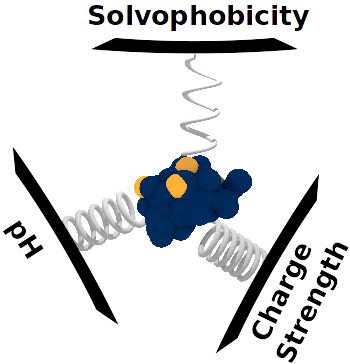Smart, responsive polyelectrolyte materials
An illustration of the inherent tug of war between solvophobic (self-association) interactions, charge coupling strength, and pH in determining the swelling behavior of an isolated weak polyelectrolyte.
Polyelectrolyte materials, both natural and man-made, have a wide
variety of applications. Within the Whitmer Group, we are interested
in elucidating important phase transitions, instabilities and
responses of polyelectrolytes and their complexes.
A topic of particular interest is the use of oligomers and polymers
within charge-sensitive separation membranes. Our work has
demonstrated through a minimal thermodynamic model that a host of
effects, including molecular size, pH responsiveness, and competetive
ion rejection may be engineered into these materials through
predictive simulations.
Additionally, our group is interested in the fascinating interplay
of charge, topology, and adhesive interactions which arise in
complex coacervate materials. These materials occur in systems of
oppositely charged macromolecules, and are intimately related to the
phenomenon of layer-by-layer deposition. We are currently developing
minimal models to test the limits of available theories of
polyelectrolyte, and to understand the microstructure, including
salt and small-molecule partitioning effects, within these phases.
Related Publications:
[1] Jian Qin, Dimitrios Priftis, Robert Farina, Sarah L. Perry, Lorraine Leon, Jonathan Whitmer, Kyle Hoffmann,
Matthew Tirrell, and Juan J. de Pablo. "Interfacial tension of
polyelectrolyte complex coacervate phases." ACS Macro Letters
3, 6 (2014):
565-568.
Link [2] Sarah L. Perry, Lorraine Leon, Kyle Q. Hoffmann, Matthew J. Kade, Dimitrios Priftis, Katie A. Black, Derek Wong, Ryan
A. Klein, Charles F. Pierce III, Khatcher O. Margossian, Jonathan K.
Whitmer, Jian Qin, Juan J. de Pablo and Matthew Tirrell. "Chirality-selected phase behaviour in ionic polypeptide complexes." Nature Communications 6 (2015): 6052.
Link [3] Vikramjit Singh Rathee, Siyi Qu, William A. Phillip, and
Jonathan K. Whitmer. "A coarse-grained thermodynamic model for
the predictive engineering of valence-selective membranes."
Molecular Systems Design & Engineering
1, 3 (2016):
301-312.
Link [4] Vikramjit Singh Rathee, Aristotle J. Zervoudakis, Hythem Sidky, Benjamin J. Sikora and Jonathan K. Whitmer. "Weak Polyelectrolyte Complexation Driven by Associative Charging." Submitted, (2017).
[5] Vikramjit Singh Rathee, Benjamin J. Sikora, Hythem Sidky and Jonathan K. Whitmer. "Simulating the Thermodynamics of Charging in Weak Polyelectrolytes. The Debye-Hückel limit." In Preparation, (2017)
